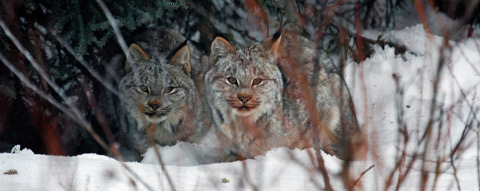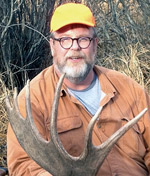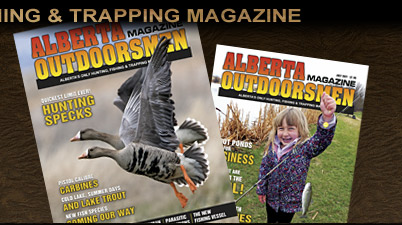|
 |
My registered trapline lies in Alberta’s foothills and while it’s not a large trapline, being 48 square miles of coniferous forest at high elevation, it provides a decent catch of fur each year. Because it’s a registered trapline, I can trap four species of furbearers there (lynx, fisher, otter and wolverine) that are off-limits on my resident trapline, which is obviously much smaller.
On my resident trapline, I trap coyotes, beaver and muskrats for a large ranch, as well as a couple of other landowners in the area. Coyotes, beaver and muskrats on my registered trapline are nearly non-existent; in fact, I’ve yet to hear a coyote howl and only know of two beaver houses on the entire line.
 |
Two lynx the author could have shot while lynx trapping.
He could have filled his lynx quota in a single day. |
There, I mainly trap marten, fisher, mink, lynx, ermine and squirrels. I have wolves, two packs that I know of, but circumstances haven’t given me the option to catch them yet. I had them figured out last year and was about to hit them hard when massive snowfalls sent them down to lower elevations and I never saw them again. This year, time got in the way of my wolf trapping.
On my registered trapline, the quota for lynx, fisher and otter is small. My otter quota is two, but I’ll never catch one, as the only decent water on my trapline short of many small meandering creeks is the headwaters of a moderate-sized creek without fish—there are no otter here that I know of. My fisher quota is three, which is probably where it should be, as every year I manage to catch at least one; this year I filled my quota with two big males and a female. I’m sure there’s wolverine here (wolverine quota is one) but I have yet to catch one, so this quota is probably correct as well, at least for this line. My lynx quota, however, is far from correct, being set at five.
Through the late 1970s and into the late 1980s, lynx pelts were in great demand and were commanding high prices at auction (lynx pelts averaged $400 to $800 during this time). Unfortunately, according to the Alberta Furbearer Harvest Data Analysis report (2001), lynx numbers were in decline in the early 1980s and few were being harvested by trappers.
In 1987, Alberta Fish and Wildlife biologist at the time, Arlen Todd, became alarmed with Alberta’s lynx population because “lynx harvest returns were declining despite abundant and increasing hare populations.” He then instituted a quota on lynx province-wide, believing that “excessive trapping caused a significant reduction in lynx numbers”, even though lynx had just gone through a cyclic peak in the early 1980s and were still in recovery mode.
Many trappers today believe that Todd over-reacted and correlated the drop in lynx numbers solely to over-trapping when, most likely, they hadn’t yet recovered from their cyclic population crash and trapping had little to do with it. It should be noted that lynx numbers are hard to quantify because of their secretive nature. Alberta lynx are designated “Not at Risk” in Alberta by COSEWIC.
Since around 1988, lynx numbers in Alberta have remained steady and while it is easy to suggest that the quota system has played a part in this, the fact remains that lynx aren’t being managed properly in many parts of the province, with many dying of starvation during cyclic crashes. This high rate of starvation, mainly among the young, could be avoided with higher trapper effort. Unfortunately, given the quota system, trappers can only harvest what is allotted to them and much of the resource is wasted.
 |
| Dave Kay |
According to Dave Kay, Commercial Wildlife and Priority Species Specialist for Alberta, “ESRD is collecting information on furbearer harvest and trapping effort, as well as demographic information on quota species (wolverine, otter, lynx and fisher) to help inform a more adaptive harvest model.”
Quite possibly, harvest and trapper effort could determine the quota for each RFMA.
Meanwhile, back on my registered trapline, I filled my lynx quota of five in about 10 days, probably less if you knew exactly the moment when the lynx were caught. I had a mere nine lynx cubbies set and all were within a three-mile radius of each other.
On my first check of those nine cubbies, I caught two lynx and could have shot three more that same day that I saw during my travels. My second check produced three more lynx and I was done lynx trapping. This happens to me yearly on this trapline; in fact, trying to stay at my quota and not above it is a serious challenge.
The term “compensatory mortality” is a term used to describe the harvest within the harvestable surplus. Said another way, to remove the surplus animals that are going to die anyway. As lynx go in Alberta, quotas don’t allow this and the surplus is often wasted. Management of furbearers by individual RFMA would stop that waste. ■
For previous Outdoor Pursuits click here.
|
|
|
|


